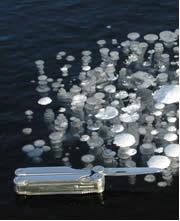 Methane bubbles trapped in lake ice during the first few days of ice formation on a Siberian thermokarst lake in October 2003.
Methane bubbles trapped in lake ice during the first few days of ice formation on a Siberian thermokarst lake in October 2003.Lakes in the permafrost zone of northern Siberia are belching out much more of the greenhouse gas methane into the atmosphere than previously thought. In coming decades this could become a more significant factor in global climate change.
The Siberian lakes, which are formed in melting permafrost as temperatures rise, have long been known to emit methane — a more potent greenhouse gas than carbon dioxide. But it has been hard to quantify just how much methane was being released. Rather than being emitted in a constant stream, 95% of the methane comes from random bubbling in disperse locations.
To get around this problem, an international group of researchers, led by Katey Walter of the University of Alaska Fairbanks, pinpointed methane bubble zones by walking over two frozen lakes near the Northeast Science Station in Cherskii, finding spots where gas could be seen trapped in pockets under the ice. In some spots the bubbling was so fierce that the warm gas melted the frozen surface.
The team then returned in spring and set up 1-metre-wide, umbrella-shaped traps to capture and measure the gas: 25 traps were placed in random locations, with 16 more over point sources identified in the winter. The team also made ground surveys of 35 other lakes, and took aerial photographs of some 60 lakes in northern Siberia, to ensure that the two studied in depth weren't unusual.
Their results, when extrapolated, show that northern Siberia currently emits 3.8 million tonnes of methane this way each year — up to five times higher than previous estimates. The results, reported in Nature1, suggest that the total release of methane from wetlands in the Northern Hemisphere may be between 10% and 63% higher than previously thought.
Thaw point
This is just a small portion of the total amount of methane released to the atmosphere: some 410 million to 660 million tonnes are thought to be pumped out by industry and natural sources each year. But the contribution from thawing lakes could increase.
Rising temperatures have increased the area of thawing lake in northern Siberia by 14.7% from 1974 to 2000. Walter's team estimates this would have bumped up methane release by 58%.
The Siberian permafrost region has the potential to release billions of tonnes of methane, says Walter. "It is a ticking time bomb," she says.
ADVERTISEMENT
Walter notes that the Siberian permafrost region is probably a far more potent source of methane than the permafrost zones of North America and Western Europe. Before the previous ice age, northern Siberia was a verdant grassland with abundant wildlife, which was frozen into a huge reservoir of carbon during the Pleistocene, some 40,000 years ago. When this ancient organic matter thaws, it is attacked by methane-producing bacteria.
But a warming world does not necessarily mean more methane from these lakes, notes Gerhard Krinner, a climatologist at the CNRS Laboratory of Glaciology and Geophysics of the Environment near Grenoble, France. Previous work has suggested that rising temperatures will eventually decrease the lake area in permafrost regions, as the ground beneath pools of water thaws completely and allows the water to drain away.
But it will be a long time, says Walter, before areas with continuous permafrost thaw enough to allow that to happen; in the meantime, she cautions, we're in for a large increase in greenhouse gas.
Visit our lakesinsiberiaemit.html">newsblog to read and post comments about this story.
-
References
- Walter K. M., Zimov S. A., Chanton J. P., Verbyla D. & Chapin F. S. Nature, 443. 71 - 75 (2006). | Article |
